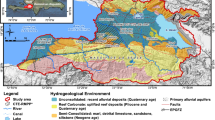Abstract
Karst aquifers that are dominated by conduit recharge are at high risk of contamination because there is little filtration or sorption of contaminants in the water. Identifying flow paths through conduit aquifers is required in order to delineate basin boundaries and potential areas at risk from groundwater contamination. In this study we report on the first continuous (~1 year) discharge and water quality data set ever collected from the Boils spring on the Highland Rim of middle Tennessee. The Boils drains the Roaring River-Spring Creek system, a State Scenic River and Wildlife Management Area. We also report on the results of a quantitative dye trace that was done to identify surface contributions to this spring. At the Boils, we measured discharge, temperature, and specific conductance for an approximate one-year period. The average annual discharge of the Boils during 2015 was 2.1 m3/s, with storm discharge reaching as much as 14 m3/s. Conductivity at the Boils spring ranged from 310 μS at baseflow to 290 μS during storm events. Water temperature of the spring varied seasonally from 9 to 22 °C. The dye trace revealed a direct connection to the Boils from a sink located 9 km away (straight-line distance), with a travel time of about 12 h. A second trace at another sink covered a straight-line distance of 1.5 km in 4 h. The rapid travel times suggest that this aquifer is dominated by conduit flow and that further research to sample water quality is warranted. Our data help to fill an important gap in data about major spring discharge and water quality in Tennessee.
Access this chapter
Tax calculation will be finalised at checkout
Purchases are for personal use only
Similar content being viewed by others
References
Du Preez, G., V. Wepener, and I. Dennis. 2016. Metal enrichment and contamination in a karst cave associated with anthropogenic activities in the Witwatersrand Basin, South Africa. Environmental Earth Sciences 75 (8): 1–13.
Field, M.S. 1993. Karst hydrology and chemical contamination. Journal of Environmental Systems 22 (1): 1–26.
Ford, D., and P. Williams. 2007. Karst Hydrogeology and Geomorphology, 562. Chichester, UK: Wiley.
Goldscheider, N., and D. Drew. 2007. Methods in Karst Hydrogeology, 264. London: Taylor and Francis.
Greene, E.A. 1997. Tracing recharge from sinking streams over spatial dimensions of kilometers in a karst aquifer. Ground Water 35 (5): 898–904.
Keswick, B.H., D.S. Wang, and C.P. Gerba. 1982. The use of microorganisms as ground-water tracers: A review. Ground Water 20 (2): 142–149.
Liñán Baena, C., B. Andreo, J. Mudry, and F. Carrasco Cantos. 2009. Groundwater temperature and electrical conductivity as tools to characterize flow patterns in carbonate aquifers: The Sierra de las Nieves karst aquifer, southern Spain. Hydrogeology Journal 17 (4): 843–853.
Padilla, A., A. Pulido-Bosch, and A. Mangin. 1994. Relative importance of baseflow and quickflow from hydrographs of karst springs. Ground Water 32 (2): 267–277.
Pronk, M., N. Goldscheider, and J. Zopfi. 2007. Particle-size distribution as indicator for fecal bacteria contamination of drinking water from karst springs. Environmental Science and Technology 41 (24): 8400–8405.
Quinlan, J.F., and E.C. Alexander Jr. 1987. How often should samples be taken at relevant locations for reliable monitoring of pollutants from an agricultural, waste disposal, or spill site in a karst terrane? A first approximation. In Proceedings of the 2nd multidisciplinary conference on sinkholes and the environmental impacts of Karst, ed B.F. Beck, and W.L. Wilson, 277–286. Rotterdam: A.A. Balkema.
Quinlan, J.F., and R.O. Ewers. 1985. Ground water flow in limestone terranes: Strategy rationale and procedure for reliable, efficient monitoring of ground water quality in karst areas. In Proceedings of the fifth national symposium and exposition on aquifer restoration and ground water monitoring May 21–24, 1985, The Fawcett Center, Columbus, Ohio.
Ryan, M., and J. Meiman. 1996. An examination of short-term variations in water quality at a karst spring in Kentucky. Ground Water 34 (1): 23–30.
Shuster, E.T., and W.B. White. 1972. Source areas and climatic effects in carbonate groundwaters determined by saturation indices and carbon dioxide pressures. Water Resources Research 8 (4): 1067–1073.
Vesper, D.J., and W.B. White. 2003. Metal transport to karst springs during storm flow: An example from Fort Campbell, Kentucky/Tennessee, USA. Journal of Hydrology 276 (1): 20–36.
White, W.B., and E.L. White. 1989. Karst hydrology, concepts from the Mammoth Cave Area, 346. New York: Van Nostrand Reinhold.
White, W.B. 2002. Karst hydrology: Recent developments and open questions. Engineering Geology 65 (2): 85–105.
Author information
Authors and Affiliations
Corresponding author
Editor information
Editors and Affiliations
Rights and permissions
Copyright information
© 2018 Springer International Publishing AG
About this paper
Cite this paper
Gardner, R., Hart, E., Sutherland, C. (2018). Delineation of a Major Karst Basin with Multiple Input Points, Roaring River, Tennessee. In: White, W., Herman, J., Herman, E., Rutigliano, M. (eds) Karst Groundwater Contamination and Public Health. Advances in Karst Science. Springer, Cham. https://doi.org/10.1007/978-3-319-51070-5_33
Download citation
DOI: https://doi.org/10.1007/978-3-319-51070-5_33
Published:
Publisher Name: Springer, Cham
Print ISBN: 978-3-319-51069-9
Online ISBN: 978-3-319-51070-5
eBook Packages: Earth and Environmental ScienceEarth and Environmental Science (R0)




